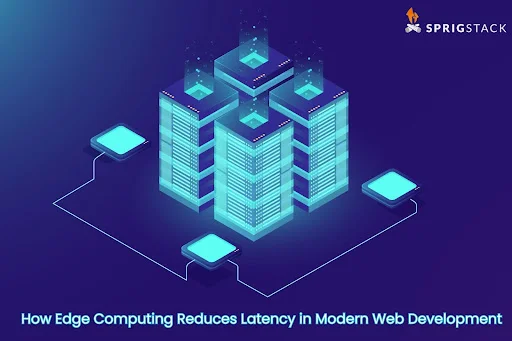A present-day web development company needs to prioritize speed, reliability, and usability in the current digital environment. This is because everything today is fast-paced. Internet users demand fast-loading websites and applications that provide them with an error-free experience. They want it regardless of location or device. Latency reduction is an even greater priority now than ever before with the expansion of real-time applications, bandwidth-intensive applications, and global audiences for Edge Computing.
Latency simply refers to the time the system spends responding to a user’s action. Even a delay of a few milliseconds can slow down the apps and websites in our current age. Such speed requirements may be challenging for traditional centralized servers, particularly when users are distant from the hosted data center.
This is where edge computing enters the scene. Edge computing significantly reduces the latency by placing processing closer to the end customer. Rather than relying on one big server worldwide, data travels through a wide range of edge nodes located at many points across the planet. This allows much faster page loading, updates that occur in real-time, and much smoother operation, which is even appropriate for coders and end users.
Expand your knowledge with this handpicked companion read.
What Is Edge Computing?
In edge computing, data handling happens close to where the data comes from or where the person is. Edge nodes, which are like small data centers closer to the user, handle computer jobs instead of sending data to a central cloud server.
This change in architecture makes it possible to handle data faster and puts less stress on central computers. Thus, websites can hold and dispense both static assets and dynamically generated content. This results in faster transfer time for the data between the client and the server.
Edge computing works with cloud computing, not instead of it. Core data and business logic may still be in the cloud, but jobs that need to be done quickly and get a lot of traffic are sent to the edge.
The Role of Latency in Web Development
Latency has a direct effect on how users feel. This is what can happen when latency is high:
- Slow page loads
- Delayed API responses
- Glitchy video calls or live feeds
- Reduced conversion rates
Delays, even in small amounts of time, could greatly expense industries such as banking and e-commerce. A reputable web development firm understands that low latency should not be just nice to have, but rather necessary.
Lowering latency makes sure that programs reply in less than a second. This improves user communication, SEO results, and makes the site more useful overall.
How Can Edge Computing Lower Latency
By bringing consumers closer to the computers that handle data, edge computing cuts down on latency. This technology makes modern web apps speedier and lets users communicate with them in real time.
Brings Content Closer to the User:
With edge computing, the customer and the computer are closer together. Round-trip time is cut down when requests are handled by edge computers nearby instead of central servers far away.
For example, if someone in Manchester visits a website stored on an edge server in London, the latency is much lower than if they visited the same website from a server in the US.
Supports Real-Time Data Processing:
Chat applications, online games, live sports scores, and stock trading platforms are all examples of modern apps that employ real-time data. With edge computing, you can deal with data immediately at or near the source.
This real-time capability makes systems more adaptable and helps individuals make better choices, especially in systems that are vital to the goal.
Lessens the Workload on Central Servers:
The edge servers can do some of the work. This means that the central servers don’t have to process as many requests. This load sharing helps speed things up and also makes the system more stabilized.
It also ensures that there will be fewer crashes during rush hours.
Enables Smarter Caching:
Edge computers are smart enough to store both static and dynamic material in cache. You can store things like user settings, session data, or popular product pages at edge sites. So, each request doesn’t have to get info from the central computer as often.
As a result? Less lag for the user and faster delivery of information.
Benefits of Edge Computing for Web Developers
Edge computing provides several advantages that speed up programs and make development easier. It provides creators the tools they need to develop digital experiences that can grow, move quickly, and be more flexible.
- Improved UX (User Experience): Less latency means that pages load faster and exchanges run more smoothly for users. The interest and retention go up.
- Scalability: Edge design makes it easier to handle traffic spikes. This is very important for a growing web development service provider when putting out popular apps.
- Enhanced Security: Edge nodes can stop insufficient data from getting to the central server by filtering it. Distributed denial-of-service (DDoS) attacks and data breaches are less likely to happen with this extra layer of security.
- Cost-Efficiency: If you handle and screen data locally, you use less bandwidth. In the long run, this means that computer storage and data transfer prices will go down.
Real-World Use Cases
Edge computing isn’t just an idea; it’s already making it better for many businesses to offer digital experiences. Let’s look at how businesses in the real world can gain from better speed and less latency.
- E-commerce: Customers of online shops can save pictures, prices, and reviews of products on edge computers. This keeps the site fast and responsive across areas during flash sales.
- Video Streaming: Edge servers help platforms like Netflix and YouTube stream material quickly and efficiently to users worldwide. This cuts down on stuttering and makes the movies and videos better.
- IoT Applications: Numerous pieces of smart equipment in homes and businesses create vast amounts of data. If you process this info at the edge, you can respond immediately without waiting for cloud latency.
- Progressive Web Apps (PWAs): Edge computing is advantageous for Progressive Web Apps because it enables offline functionality, faster file loading, and seamless syncing when the user returns online.
What Developers Should Consider
Edge computing is practical, but it isn’t always the best option. This is what a current web development firm should think about:
- In what parts of their system does latency happen?
- What kinds of tasks can be sent to the edge?
- What type of CDN or edge service works best with their business model?
To fully utilize edge computing, you need to plan, test, and apply it in the correct way.
Conclusion
Edge computing is changing how developers build and serve web apps. Bringing computers closer to users and decentralizing them lowers latency. It speeds up data processing, and improves the whole user experience. A web development company that wants to stay competitive must now use edge computing or risk falling behind the competition.
Edge computing will have an even bigger impact on the future of web development as the need for fast, dependable digital services increases.
Want more insights like this? Head over to Management Works Media and start exploring.






